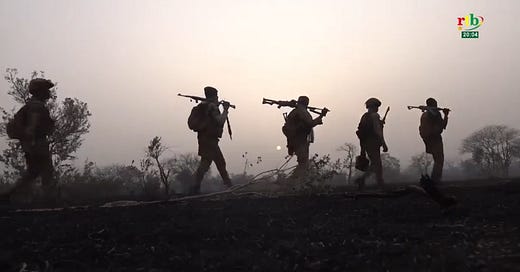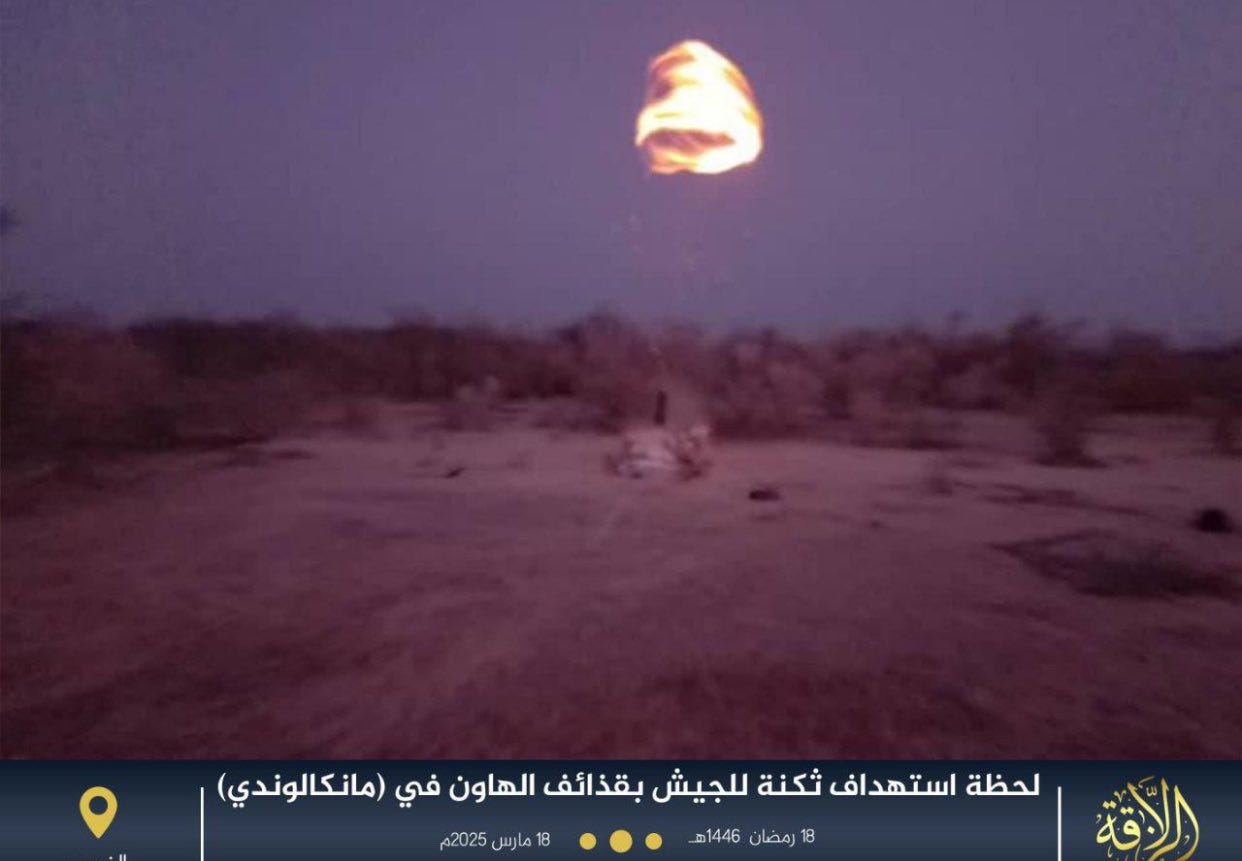It has been a frenetic and violent month for Burkina Faso, which, given its position as the world’s most affected country by terrorism over the past two years, is perhaps unsurprising. However, several significant developments in the country over the past month offer insight into the trajectory of the Sahel’s enduring violence.
Burkinabè Forces Launch Major Offensive
Over the past week, state security personnel (FDS) and the civilian auxiliary force, Volunteers for Defence of the Homeland (VDP), have launched a major offensive operation in Sourou valley, Sourou Province. The operation has been a success, with a list of towns and villages dotted along the border with Mali reportedly liberated from the control of Jama’at Nusrat al-Islam wal-Muslimin (JNIM).
Security forces entered the large towns of Di and Guiédougou on 21 and 22 March, respectively, where jubilant residents were filmed greeting their arrival. A correspondent from the Burkinabè news outlet RTB was dispatched to Di, which had been under JNIM control since March 2024, to report on the experience of local residents.
The reporter began his segment by claiming, “they have returned from hell, hell created by the terrorists”. Interviews with locals painted a grim but now all-too-familiar picture of life under JNIM control. The jihadists stole precious livestock, forced men to pray and women to wear a hijab, and imposed taxes on the local populace, residents claimed.
The accounts shared by Di’s civilians offer a glimpse into the experiences of millions across the Sahel who are caught in the crossfire of the region’s escalating conflict - personal stories often overshadowed by the heavy focus on violence and bloodshed.
The recapture of these settlements may temporarily complicate JNIM’s ability to maintain influence in the region; however, there should be little doubt that the group will try to regain control when the opportunity presents itself.
The VDP’s Continued Crimes
The ongoing crimes committed by Burkinabè security forces against civilians mean that simply defeating JNIM militarily is not enough to curb its growing dominance - its expanding reach throughout the region is fuelled by far more than just offensive potency.
In the recent RTB report from the Sourou valley, some of the young men interviewed voiced their eagerness to join the VDP and help their country emerge victorious in its existential battle against terrorism.
The VDP is a divisive actor, to say the least. For some Burkinabè, they are heroes willing to put their lives on the line to protect their communities and country. For others, the VDP is simply another armed actor, ready to use extreme violence on those deemed enemies.
Indeed, often composed of ill-disciplined and poorly trained men with a strong desire for revenge, the VDP has massively exacerbated cycles of ethnic conflict by systematically targeting communities it believes are complicit in extremist violence and activity. The semi-nomadic Fulani community is often the victim of VDP violence.
The belief that the Fulani are culpable in the proliferation of violent extremists across the Sahel is not entirely unfounded. Decades of discrimination and exclusion by the government and fellow ethnic groups mean the Fulani are overrepresented in the ranks of terrorist groups.
The violence committed against them by state forces has pushed more members of the community seeking revenge or protection into the arms of terrorist groups, while others decide to live or cooperate with extremists due to a lack of better alternatives.
The devastating effects of this self-fulfilling prophecy were showcased again earlier this month. On 10 and 11 March, the FDS and VDP conducted major operations to push out jihadists from another part of Burkinabè territory along the border with Mali, this time around the city of Solenzo.
Triumphant footage soon emerged showing members of the Rapid Intervention Battalion 18 (BIR-18), a special forces counterinsurgency unit based in Solenzo, returning from a mission with hundreds of cattle. One Facebook account sharing the footage claimed, “terrorists feel in danger everywhere in Solenzo”.
However, it quickly became clear that these operations had a far more sinister story. Videos quickly surfaced online showing dozens of dead men, women, and children, alongside many others alive, many visibly wounded and tied up. Pictured around them were not terrorists, but men wearing VDP uniforms.
Many of the victims are believed to be Fulani. In some videos, men are heard berating critically injured mothers lying next to their children. One piece of footage sees a man exclaiming, “You, the Fulani people, do you think you can take over Burkina Faso? You will never! What is left for you to do here is to disappear. Where are those holding weapons?”
These reports quickly gained international attention, but the Burkinabè government doubled down on its support for the VDP. In a statement, it claimed that a disinformation campaign had misrepresented the recent events “to the utmost extent, to discredit our valiant fighters” and to incite hatred and communal violence and destabilise the country.
The refusal of Burkinabè leader Ibrahim Traoré to rein in the ethnically-motivated violence committed by his armed forces and the VDP has led to warnings that conflict in the country could escalate dramatically along ethnic lines. The leader seemingly shares the same belief as his civilian fighters, however.
In stark contrast to the government’s reaction to the atrocities in Solenzo, JNIM denounced the VDP’s frequent killings of civilians and pledged to take revenge, not just for the Fulani victims, but for anyone impacted by state violence. The militant group even provided aid to the affected communities and ominously promised that "the orphans will be taken care of, and if they want to join the jihad when they are old enough, they would be at the forefront".
New Battleground, New Capabilities
Revenge was dealt swiftly by JNIM. The group unleashed a wave of attacks against Burkinabè security forces in the weeks following the atrocities in Solenzo, with an apparent focus on the two neighbouring provinces of Gourma and Koulpélogo.
Between 14 and 29 March, JNIM has publicly claimed responsibility for at least 16 attacks in these two provinces alone. The most devastating of these attacks came against a military base in Diapaga, which reportedly killed over 30 soldiers and 20 VDP and led to major destruction.
The high volume of recent operations in Burkina Faso’s Est and Centre Est regions is not an anomaly, but reflects the strategic importance of the border areas between the Sahel and West Africa’s coastal states.
A central role in JNIM’s southward expansion along this front has been the W-Arly-Pendjari Park Complex, which spans swathes of northern Benin and parts of southern Burkina Faso and Niger.
JNIM is firmly entrenched in the vast nature reserve, which is difficult to survey and monitor. The park complex now serves as a launchpad for the group to both further its presence in Benin and to conduct attacks and operations in nearby states.
JNIM militants based in this part of the region have recently showcased new offensive capabilities. Over the past two weeks, the group has launched three mortar attacks targeting military bases in Makalondi and Mossipaga, Niger, and Kantchari, Burkina Faso.
These fighters have likely acquired this weaponry by attacking nearby military bases and posts, a critical source of arms for the group. This was demonstrated after the devastating assault on the Point Triple Base in northern Benin in early January, where the group later shared images of captured mortars.
The emergence of new forms of remote violence adds another layer of complexity to the escalating threats in this strategic corridor between the Sahel to other parts of West Africa. Security cooperation among the affected states - Burkina Faso, Niger, Benin, and, to a lesser extent, Nigeria and Togo - remains insufficient to tackle JNIM’s growing levels of activity.
Long-Standing Targets Face Drone Threats
In addition to mortars, JNIM cells in the area have reportedly recently obtained new means of remote violence. On 20 March, it was purported that two explosive-laden drones were used to attack a military position in Zongo, Koulpélogo, marking one of the first reported uses of commercially-modified drones by the group in this area.
The attack in Zongo was relatively small-scale and, by all accounts, successfully repelled by security personnel. However, it is also the latest in a growing number of reports of JNIM using explosive-laden drones in Sahel.
In late February, the Malian military announced that a drone had attempted to drop an explosive device on one of its positions in Koury. This report came just a day after social media accounts shared images of improvised explosive devices (IEDs) dropped by drones during an attack on positions near the city of Djibo in northern Burkina Faso.
Djibo is emerging as an epicentre of JNIM drone activity. Throughout March there have been numerous reports that have highlighted the group’s use of explosive-laden drones during attacks in and around the city, including one image showing a drone downed with an IED still intact.
It has been suggested that drones are being deployed to strike positions that are difficult to reach using ground forces. Since a major JNIM attack on Djibo in late November 2023, significant efforts have been made to fortify the city, which has been under siege for over three years. Large trenches and earthen embankments now surround strategic points around Djibo, with recent evidence showing JNIM militants struggling to breach them.
Drones come to be a key component of JNIM's strategy to initiate a new phase of conflict by attacking and conquering major urban centres across the Sahel.
Currently, drones are a relatively novel tactic for the organisation, but the growing number of attacks featuring this form of remote violence are evidence of its desire to comprehensively integrate them into its offensive tactics. If fully mastered, this capability could help the group penetrate well-defended strategic locations like Djibo.
What Lies Ahead?
March has been a tumultuous month for Burkina Faso, one that has showcased numerous factors that are likely to play an increasingly important role in the country’s future and that of the surrounding region. How these factors will interact with the Sahelian junta’s new responses remains to be seen.
In Burkina Faso, recruitment for the VDP continues and offensive operations remain ongoing in the country’s west and beyond. In Mali, significant sums of vehicles and other military equipment have been flooding into the country since the turn of the year. Potentially clearing the ground for future large-scale operations, the military has also launched a coordinated campaign of drone strikes targeting militant logistics and supply lines. Niger has seemingly set the stage for the arrival of foreign troops, with reports already surfacing that Syrian and Russian fighters have been deployed to the northern city of Arlit.
Taken together, these recent developments offer few conclusions other than an intensification of violence and conflict in the Sahel, the outcome of which remains to be seen.








La mort ou la patrie nous vaincrons. Thomas Sankara